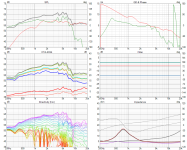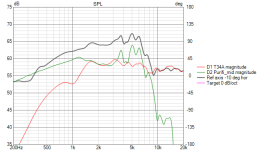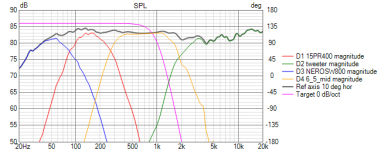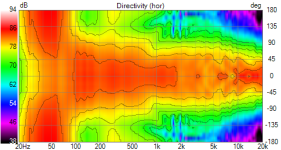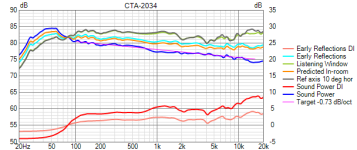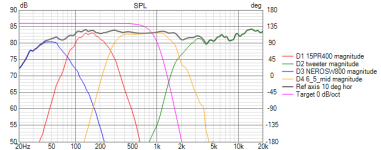Looks like I am not the only one trying to seriously 3D print full speaker cabinets.. 🙂
That quote is quite specific and not entirely accurate.Floyd Toole mentioned double bass arrays recently. It might help you from stressing too hard over it.
The Bliesma T34A seems to be a rowdy tweeter. Its wants to affect everything near it with its wide radiation. 😱
The 3-4mm non-flush mounted adaptor caused the on axis response to be really bad looking to the eyes.
I had to cover the whole region with some tape to lessen its effect.
Here is a comparison of the raw measurements nearfield of the T34, and with and without tape treatment on the baffle

The whole speaker now looks like it had been to the hospital after a fight.. 😀

Purifi mid driver responses

T34A responses

Prototype crossover based on 10 degrees off axis as reference


I will print another adaptor and redo measurements again..
This time I also forgot to take mid driver measurements on the drivers axis. Instead I took all measurements on tweeter axis..
The 3-4mm non-flush mounted adaptor caused the on axis response to be really bad looking to the eyes.
I had to cover the whole region with some tape to lessen its effect.
Here is a comparison of the raw measurements nearfield of the T34, and with and without tape treatment on the baffle
The whole speaker now looks like it had been to the hospital after a fight.. 😀
Purifi mid driver responses
T34A responses
Prototype crossover based on 10 degrees off axis as reference
I will print another adaptor and redo measurements again..
This time I also forgot to take mid driver measurements on the drivers axis. Instead I took all measurements on tweeter axis..
Attachments
Last edited:
Here is a comparison of the raw measurements nearfield of the T34, and with and without tape treatment on the baffle
Unfortunately this was to be expected.
"Surface mounted tweeter with 1/8" (3.175mm) flange, relative to flush mounted"
The reason why the step is quite damaging (at least to the eyes) even though it is only a small dimension vertically is due to its distance from the source and the fact that it exists at the same distance in any direction. If the step was the other way around, the baffle was higher than the insert it would have been worse again.I have noticed a measurable effect from geometric disturbances near the tweeter down to about about 1/10 wavelength. 3.5 mm is a wavelength of 98k, so 1/10 wavelength is 9.8k. I very much doubt it will be noticeable or even measurable.
I think if I get rid of the reflections from those protruding edges around the tweeter, this would make a nice speaker (above 200Hz).. 🙂
Don't know what will be the effect of that raised surround ridge of the Purifi right just above the tweeter edge..

Maybe its effects might show up once I get rid of the other issue..
Here is a simple passive crossover


Full range response


Don't know what will be the effect of that raised surround ridge of the Purifi right just above the tweeter edge..
Maybe its effects might show up once I get rid of the other issue..
Here is a simple passive crossover
Full range response
The full 4-way system

I still think this whole system has some potential (even without the waveguide on tweeter) if I can get rid of that chewed-up response in the highs due to non-flush mounting created reflections 🙂



I still think this whole system has some potential (even without the waveguide on tweeter) if I can get rid of that chewed-up response in the highs due to non-flush mounting created reflections 🙂
Attachments
That quote is quite specific and not entirely accurate.
Curious what you think about this quote. If you only have two mains would it be preferable to decouple the low frequencies to achieve a flat steady state and suffer the consequences of time domain problems or would it be better to accept a disrupted steady state in favor of accurate time domain?
Assuming you don't use multi-subs or near-field subs. Only two mains.
https://audiosciencereview.com/foru...s-rainmaker-speaker-review.40906/post-2216620
Decorrelation is disorder - i.e. each source of low frequencies is in a random time sequence with others. It almost certainly will reduce coherent coupling to room modes which is good, but it will change the time domain structure of the bass. The purpose of multiple subs is to coherently couple energy to modes but in a fashion that attenuates specific sets of room resonances. With these attenuated, the recorded bass is heard without the detrimental effects of standing waves. Using subs means that the main speakers can play louder with lower distortion. For a single listener or a small number, near-field subwoofing is an alternative or an addition.
I can't say I can image what type of filter would create decorrelation at low frequencies if there are only two speakers one for each channel.Curious what you think about this quote. If you only have two mains would it be preferable to decouple the low frequencies to achieve a flat steady state and suffer the consequences of time domain problems or would it be better to accept a disrupted steady state in favor of accurate time domain?
In terms of time domain vs frequency domain Bruno Fazenda's research showed that reducing decay to below a defined threshold (there are graphs in one of the papers) gave higher preference scores, and frequency response was not a very important factor at the lowest frequencies in terms of preference.
Of course this does not mean that frequency response does not matter, but it might well matter much less than you think at low frequencies. If through bad placement or SBIR effects there is a massive modal problem you will of course hear that and the sound will improve by reducing the peak.
Are apples better than oranges? I don't like to eat oranges, but if I needed to clean something an orange would be more useful to me than an apple.
TL : DR It depends 😉
I printed a new adaptor for tweeter such that the tweeter is now flush mounted and remeasured everything.. 🙂
New tweeter+mid cab

Tweeter polars

Purifi Mid polars

And then integrated everything to make a 4way speaker.. 🙂
Like this

Crossover and overall speaker polars


MLP measurements

Phase matching between tweeter and woofer is not as good as I would like.. but I will refine it later
Right now I am just listening to the mono speaker before I print the 2nd cab..
So far all I can say is that it sounds nice.. 🙂
New tweeter+mid cab
Tweeter polars
Purifi Mid polars
And then integrated everything to make a 4way speaker.. 🙂
Like this
Crossover and overall speaker polars
MLP measurements
Phase matching between tweeter and woofer is not as good as I would like.. but I will refine it later
Right now I am just listening to the mono speaker before I print the 2nd cab..
So far all I can say is that it sounds nice.. 🙂
But with two 15" drivers per side, I am concerned that you might not have enough SPL capability?
🙂
🙂
@hifijim: yes that is true.. 😀
Once while testing the 15PR400 driver for measurements, I accidentally clicked the check levels option in REW with the minidsp volume control near max and the 130W amplifier the driver was connected to at max level.
Nearly succeded in tearing my ears off my head that day.. 😀
Once while testing the 15PR400 driver for measurements, I accidentally clicked the check levels option in REW with the minidsp volume control near max and the 130W amplifier the driver was connected to at max level.
Nearly succeded in tearing my ears off my head that day.. 😀
@tktran303: I did that because of the following reasons but none of these have anything to do with superiority of one concept over the other. Just because of some things I found in my listening space
1) Easier to integrate the sub driver and the 15pr400 bass mid driver with this kind of set up.
2) Even with cardioidish down to 100Hz, I didn't get much advantages regarding SBIR, atleast the major issues caused (most probably) by ceiling reflections in the 200Hz range that was making my graphs look bad earlier
3) Below 150Hz or so I still have all the effects of room modes whether cardioid or not atleast in this space.
4) I was finding it easier to blend the different driver DI curves into a relatively smoothly rising up overall SPDI with this configuration. In fact I haven't tried to blend this two way top much with the cardioidish woofer configuration much.
I will probably try out the cardioidish dual woofer configuration sometime as well..
1) Easier to integrate the sub driver and the 15pr400 bass mid driver with this kind of set up.
2) Even with cardioidish down to 100Hz, I didn't get much advantages regarding SBIR, atleast the major issues caused (most probably) by ceiling reflections in the 200Hz range that was making my graphs look bad earlier
3) Below 150Hz or so I still have all the effects of room modes whether cardioid or not atleast in this space.
4) I was finding it easier to blend the different driver DI curves into a relatively smoothly rising up overall SPDI with this configuration. In fact I haven't tried to blend this two way top much with the cardioidish woofer configuration much.
I will probably try out the cardioidish dual woofer configuration sometime as well..
I've been focused on single point solutions for a long time. When I see vertical polar maps like in post#2211, the first one you see scrolling backwards, I feel that the compromises involved in single point solutions are well justified. But that is just based on looks at graphs. Your speaker is likely perfectly OK listening on vertical axis but what is it like when you go off axis vertically? Can you show a vertical line chart?
The crossover shown in the above post had a major issue when I sat down and listened to a few songs. 🙂
The tonality was nice overall but I could sometimes hear part of the vocals shifting from the 15PR400 to the Purifi driver from 2.5m away at MLP.
Once I heard it, I just couldn't stand it.. It was so distracting for me.. I was trying all I could to keep the excess group delay as much down as possible earlier
So I increased the crossover order from second order to 4th order 4th order on the 15PR400 and let the Purifi play lower down.. 🙂
Current crossover



Anyway, now the whole mono speaker sounds phenomenal 🙂
Vocals come from the right height. I seem to hear much more things/minute details in songs that I might not have earlier heard/paid attention to..
I am not concerned about the excess group delay rise yet since I have not heard anything suggesting an issue in a variety of tracks till now..
My complaints from the previous speaker about attention-capturing behaviour at certain ranges are gone now.. 🙂
It is all relaxed sounding and I am able to focus on music as a whole..
I tried standing and listening, walking away, walkaing towards, lying down etc from 2.5m away as reference point.. There is no significant tonality shift I could notice even while actively trying to hear that.. 🙂
I am happy now.. I can see myself staying with this speaker for a while... 😀
(PS: I know the polars dont have force to gradient option forced while doing nearfield-farfield merging for some driver.. I will correct it sometime later.. 😀 )
The tonality was nice overall but I could sometimes hear part of the vocals shifting from the 15PR400 to the Purifi driver from 2.5m away at MLP.
Once I heard it, I just couldn't stand it.. It was so distracting for me.. I was trying all I could to keep the excess group delay as much down as possible earlier
So I increased the crossover order from second order to 4th order 4th order on the 15PR400 and let the Purifi play lower down.. 🙂
Current crossover
Anyway, now the whole mono speaker sounds phenomenal 🙂
Vocals come from the right height. I seem to hear much more things/minute details in songs that I might not have earlier heard/paid attention to..
I am not concerned about the excess group delay rise yet since I have not heard anything suggesting an issue in a variety of tracks till now..
My complaints from the previous speaker about attention-capturing behaviour at certain ranges are gone now.. 🙂
It is all relaxed sounding and I am able to focus on music as a whole..
I tried standing and listening, walking away, walkaing towards, lying down etc from 2.5m away as reference point.. There is no significant tonality shift I could notice even while actively trying to hear that.. 🙂
I am happy now.. I can see myself staying with this speaker for a while... 😀
(PS: I know the polars dont have force to gradient option forced while doing nearfield-farfield merging for some driver.. I will correct it sometime later.. 😀 )
Excuse me, but what is the purple line in xo graphs? Flat 86dB from 20 to 700Hz until lowpass
- Home
- Loudspeakers
- Multi-Way
- A 3 way design study
